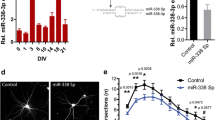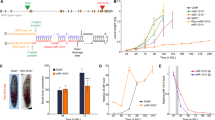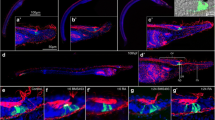Abstract
During development and regeneration, growth cones at the tips of extending axons navigate through a complex environment to establish accurate connections with appropriate targets. Growth cones can respond rapidly to classical and non-classical guidance cues in their environment, often requiring local protein synthesis. In vertebrate growth cones, local protein synthesis in response to classical cues can require regulation by microRNAs (miRNAs), a class of small, conserved, non-coding RNAs that post-transcriptionally regulate gene expression. However, less is known of how miRNAs mediate growth cone responses to non-classical cues (such as retinoic acid (RA)), specifically in invertebrates. Here, we utilized adult regenerating invertebrate motorneurons to study miRNA regulation of growth cone attraction to RA, shown to require local protein synthesis. In situ hybridization revealed the presence of miR-124 in growth cones of regenerating ciliary motorneurons of the mollusc Lymnaea stagnalis. Changes in the spatiotemporal distribution of miR-124 occurred following application of RA, and dysregulation of miR-124 (with mimic injection), disrupted RA-induced growth cone turning in a time-dependent manner. This behavioural regulation by miR-124 was altered when the neurite was transected, and the growth cone completely separated from the soma. miR-124 did not, however, appear to be involved in growth cone attraction to serotonin, a response independent of local protein synthesis. Finally, we provide evidence that a downstream effector of RhoGTPases, ROCK, is a potential target of miR-124 during RA-induced growth cone responses. These data advance our current understanding of how microRNAs might mediate cue- and context-dependent behaviours during axon guidance.









Similar content being viewed by others
Data availability
If required.
Code availability
Not applicable.
References
Altschul SF, Gish W, Miller W, Myers EW, Lipman DJ (1990) Basic local alignment search tool. J Mol Biol 215:403–410
Arakawa Y, Bito H, Furuyashiki T, Tsuji T, Takemoto-Kimura S, Nozaki KKK, Hashimoto N, Narumiya S (2003) Control of axon elongation via an SDF-1a/Rho/mDia pathway in cultured cerebellar granule neurons. J Cell Biol 161:381–391
Bartel DP (2004) MicroRNAs: genomics, biogenesis, mechanism, and function. Cell 116:281–297
Baudet ML, Zivraj KH, Abreu-Goodger C, Muldal A, Armisen J, Blenkiron C, Goldstein LD, Miska EA, Holt CE (2011) miR-124 acts through coREST to control onset of Sema3A sensitivity in navigating retinal growth cones. Nat Neurosci 15:29–40
Bellon A, Iyer A, Bridi S, Lee FCY, Ovando-Vazquez C, Corradi E, Longhi S, Roccuzzo M, Strohbuecher S, Naik S, Sarkies P, Miska E, Abreu-Goodger C, Holt CE, Baudet ML (2017) miR-182 regulates slit2-mediated axon guidance by modulating the local translation of a specific mRNA. Cell Rep 18:1171–1186
Brose K, Bland KS, Hong Wang K, Arnott D, Henzel W, Goodman CS, Tessier-Lavigne M, Kidd T (1999) Slit proteins bind robo receptors and have an evolutionarily conserved role in repulsive axon guidance. Cell 96:795–806
Buck KB, Zheng JQ (2002) Growth cone turning induced by direct local modification of microtubule dynamics. J Neurosci 22:9358–9367
Campbell DS, Holt CE (2001) Chemotropic responses of retinal growth cones mediated by rapid local protein synthesis and degradation. Neuron 32:1013–1026
Carter CJ, Farrar N, Carlone RL, Spencer GE (2010) Developmental expression of a molluscan RXR and evidence for its novel, nongenomic role in growth cone guidance. Dev Biol 343:124–137
Chen L, Lau AG, Sarti F (2014) Synaptic retinoic acid signaling and homeostatic synaptic plasticity. Neuropharmacology 78:3–12
Cheng HJ, Nakamoto M, Bergemann AD, Flanagan JG (1995) Complementary gradients in expression and binding of ELF-1 and Mek4 in development of the topographic retinotectal projection map. Cell 82:371–381
Corradi E, Gavoci A, Strohbuecker S, Rocuzzo M, Dalla Costa I, Iyer A, Bridi S, Santoz Rodriguez G, Abreu-Goodger C, Baudet ML (2018) Precursor miRNAs are trafficked along axons associated with vesicles and locally processed to regulate growth cone steering. bioRxiv. https://doi.org/10.1101/470393
Davison A, McDowell GS, Holden JM, Johnson HF, Koutsovoulos GD, Maureen Liu M, Mulpiau P, Van Roy F, Wade CM, Bangerjee R, Yang F, Chiba S, Davey JW, Jackson DJ, Levin M, Blaxter ML (2016) Formin is associated with left-right asymmetry in the pond snail and the frog. Curr Biol 26:R215–R217
Dent EW, Gupton SL, Gertler FB (2011) The growth cone cytoskeleton in axon outgrowth and guidance. Cold Spring Harb Perspect Biol 3:a001800
Dickson BJ (2001) Rho GTPases in growth cone guidance. Curr Opin Neurobiol 11:103–110
Dmetrichuk JM, Spencer GE, Carlone RL (2005) Retinoic acid-dependent attraction of adult spinal cord axons towards regenerating newt limb blastemas in vitro. Dev Biol 281:112–120
Dmetrichuk JM, Carlone RL, Spencer GE (2006) Retinoic acid induces neurite outgrowth and growth cone turning in invertebrate neurons. Dev Biol 294:39–49
Dmetrichuk JM, Carlone RL, Jones TRB, Vesprini ND, Spencer GE (2008) Detection of endogenous retinoids in the molluscan CNS and characterization of the trophic and tropic actions of 9-cis retinoic acid on isolated neurons. J Neurosci 28:13014–13024
Drescher U, Kremoser C, Handwerker C, Loschinger J, Noda M, Bonhoeffer F (1995) In vitro guidance of retinal ganglion cell axons by RAGS, a 25 kDa tectal protein related to ligands for Eph receptor tyrosine kinases. Cell 82:359–370
Edgar RC (2004) MUSCLE: multiple sequence alignment with high accuracy and high throughput. Nucleic Acids Res 32:1792–1797
Farrar NR, Dmetrichuk JM, Carlone RL, Spencer GE (2009) A novel, nongenomic mechanism underlies retinoic acid-induced growth cone turning. J Neurosci 29:14136–14142
Gershoni-Emek N, Altman T, Ionescu A, Costa CJ, Gradus-Pery T, Willis DE, Perlson E (2018) Localization of RNAi machinery to axonal branch points and growth cones is facilitated by mitochondria and is disrupted in ALS. Front Mol Neurosci 11:311
Griffiths-Jones S (2004) The microRNA registry. Nucleic Acids Res 32:D109–D111
Gu L, Black B, Ordonez S, Mondal A, Jain A, Mohanty S (2014a) Microfluidic control of axonal guidance. Sci Rep 4:6457
Gu X, Meng S, Liu S, Jia C, Fang Y, Li S, Fu SQ, Lin L, Wang X (2014b) miR-124 represses ROCK1 expression to promote neurite elongation through activation of the PI3K/Akt signal pathway. J Mol Neurosci 52:156–165
Han L, Wen Z, Lynn RC, Baudet ML, Holt CE, Sasaki Y, Bassell GJ, Zheng JQ (2011) Regulation of chemotropic guidance of nerve growth cones by microRNA. Mol Brain 4:40
Hancock ML, Preiner N, Quan J, Flanagan JG (2014) MicroRNA-132 is enriched in developing axons, locally regulates Rasa1 mRNA, and promotes axon extension. J Neurosci 34:66–78
Haydon PG, McCobb DP, Kater SB (1984) Serotonin selectively inhibits growth cone motility and synaptogenesis of specific identified neurons. Science 226:561–564
Ishii N, Wadsworth WG, Stern BD, Culotti JG, Hedgecock EM (1992) UNC-6, a laminin-related protein, guides cell and pioneer axon migrations in C. elegans. Neuron 9:873–881
Iyer AN, Bellon A, Baudet AL (2014) microRNAs in axon guidance. Front Cell Neurosci 8:78
Johnson A, Nasser TIN, Spencer GE (2019) Inhibition of Rho GTPases in invertebrate growth cones induces a switch in responsiveness to retinoic acid. Biomolecules 9:460
Jung H, Yoon BC, Holt CE (2012) Axonal mRNA localization and local protein synthesis in nervous system assembly, maintenance and repair. Nat Rev Neurosci 13:308–324
Khatib T, Marini P, Nunna S, Chisholm DR, Whiting A, Redfern C, Greig IR, McCaffery P (2019) Genomic and non-genomic pathways are both critical for peak induction of neurite outgrowth by retinoids. Cell Commun Signal 17:40
Kidd T, Bland KS, Goodman CS (1999) Slit is the midline repellent for the robo receptor in Drosophila. Cell 96:785–794
Koert CE, Spencer GE, van Minnen J, Li KW, Geraerts WP, Syed NI, Smit AB, van Kesteren RE (2001) Functional implications of neurotransmitter expression during axonal regeneration: serotonin, but not peptides, auto-regulate axon growth of an identified central neuron. J Neurosci 21:5597–5606
Kouchi Z, Igarashi T, Shubayama N, Inanobe S, Sakurai K, Yamaguchi H, Fukuda T, Yanagi S, Nakamura Y, Fukami K (2011) Phospholipase Cg3 regulates RhoA/Rho kinase signaling and neurite outgrowth. J Biol Chem 286:8459–8471
Kramer MF (2011) Stem-loop RT-qPCR for miRNAs. Curr Protoc Mol Biol. https://doi.org/10.1002/0471142727.mb1510s95
Lécuyer E, Necakov AS, Caceres AS, Krause HM (2008) High-resolution fluorescent in situ hybridization of Drosophila embryos and tissues. Cold Spring Harb Protoc. https://doi.org/10.1101/pdb.prot5019
Lingor P, Teusch N, Schwarz K, Mueller R, Mack H, Bahr M, Mueller BK (2007) Inhibitions of Rho kinase (ROCK) increases neurite outgrowth on chondroitin sulphate proteoglycan in vitro and axonal regeneration in the adult optic nerve in vivo. J Neurochem 103:181–189
Liu H, Han H, Li J, Wong L (2003) An in-silico method for prediction of polyadenylation signals in human sequences. Genome Inform 14:84–93
Liu J, Gao HY, Wang XF (2015) The role of the Rho/ROCK signaling pathways in inhibiting axonal regeneration in the central nervous system. Neural Regen Res 10:1892–1896
Loudon RP, Silver LD, Yee HF Jr, Gallo G (2006) RhoA-kinase and myosin II are required for the maintenance of growth cone polarity and guidance by nerve growth factor. J Neurobiol 66:847–867
Lowery LA, Van Vactor D (2009) A trip of the tip: understanding the growth cone machinery. Nat Rev 10:332–343
Lu J, Tsourkas A (2011) Quantification of miRNA abundance in single cells using locked nucleic acid-FISH and enzyme-labeled fluorescence. In: Shah K (ed) Molecular imaging, vol 680. Humana Press, Totowa, pp 77–88
Maden M, Gale E, Kostetskii I, Zile M (1996) Vitamin A-deficient quail embryos have half a hindbrain and other neural defects. Curr Biol 6:417–426
Maden M, Keen G, Jones GE (1998) Retinoic acid as a chemotactic molecule in neuronal development. Int J Dev Neurosci 16(5):317–322
Maekawa M, Ishizaki T, Boku S, Watanabe N, Fujita A, Iwamatsu A, Obinata T, Ohashi K, Muzuno K, Narumiya S (1999) Signaling from Rho to the actin cytoskeleton through protein kinases ROCK and LIM-kinase. Science 285:895–898
Messersmith EK, Leonardo ED, Shatz CJ, Tessier-Lavigne M, Goodman CS, Kolodkin AL (1995) Semaphorin III can function as a selective chemorepellent to pattern sensory projections in the spinal cord. Neuron 14:949–959
Mishima T, Mizuguchi Y, Kawahigashi Y, Takizawa T, Takizawa T (2007) RT-PCR-based analysis of microRNA (miR-1 and -124) expression in mouse CNS. Brain Res 1131:37–43
NCBI Resource Coordinators (2016) Database resources of the National Center for Biotechnology Information. Nucleic Acids Res 44:D7–D19. https://doi.org/10.1093/nar/gkv1290
Ohashi K, Nagata K, Maekawa M, Ishizaki T, Narumiya S, Mizuno K (2000) Rho-associated kinase ROCK activates LIM-kinase 1 by phosphorylation at threonine 508 within the activation loop. J Biol Chem 275:3577–3582
Poon MM, Chen L (2008) Retinoic acid-gated sequence-specific translational control by RARalpha. Proc Natl Acad Sci 105:20303–20308
Prince DJ, Carlone RL (2003) Retinoic acid involvement in the reciprocal neurotrophic interactions between newt spinal cord and limb blastemas in vitro. Dev Brain Res 140:67–73
Rajasethupathy P, Fiumara F, Sheridan R, Betel D, Puthanveettil SV, Russo JJ, Sander C, Tuschl T, Kandel E (2009) Characterization of small RNAs in Aplysia reveals a role for miR-124 in constraining synaptic plasticity through CREB. Neuron 63:803–817
Rajnicek AM, Foubister LE, McCaig CD (2006) Temporally and spatially coordinated role for Rho, Rac, Cdc42 and their effectors in growth cone guidance by a physiological electric field. J Cell Sci 119:1723–1735
Ren Y, Suter DM (2016) Increase in growth cone size correlates with decrease in neurite growth rate. Neural Plast 2016:3497901. https://doi.org/10.1155/2016/3497901
Rohwedel J, Guan K, Wobus AM (1999) Induction of cellular differentiation by retinoic acid in vitro. Cells Tissues Organs 165:190–202
Sadamoto H, Takahashi H, Okada T, Kenmoku H, Toyota M, Asakawa Y (2012) De novo sequencing and transcriptome analysis of the central nervous system of mollusc Lymnaea stagnalis by deep RNA sequencing. PLoS One 7:e42546. https://doi.org/10.1371/journal.pone.0042546
Sattler R, Tymianski M, Feyaz I, Hafner M, Tator CH (1996) Voltage-sensitive calcium channels mediate calcium entry into cultured mammalian sympathetic neurons following neurite transection. Brain Res 719:239–246
Schindelin J, Arganda-Carreras I, Frise E, Kaynig V, Longair M, Pietzsch T, Preibisch S, Rueden C, Saalfeld S, Schmid B, Tinevez JV, White DJ, Hartenstein V, Eliceiri K, Tomancak P, Cardona A (2012) Fiji: an open-source platform for biological-image analysis. Nat Methods 9:676–682
Serafini T, Kennedy TE, Gaiko MJ, Mirzayan C, Jessell TM, Tessier-Lavigne M (1994) The netrins define a family of axon outgrowth-promoting proteins homologous to C. elegans UNC-6. Cell 78:409–424
Spencer GE, Lukowiak K, Syed NI (1996) Dopamine regulation of neurite outgrowth from identified Lymnaea neurons in culture. Cell Mol Neurobiol 16:577–589
Spencer GE, Lukowiak K, Syed NI (2000a) Transmitter–receptor interactions between growth cones of identified Lymnaea neurons determine target cell selection in vitro. J Neurosci 20:8077–8086
Spencer GE, Syed NI, van Kesteren E, Lukowiak K, Geraerts WP, van Minnen J (2000b) Synthesis and functional integration of a neurotransmitter receptor in isolated invertebrate axons. J Neurobiol 44:72–81
Sun Y, Luo ZM, Guo XM, Su DF, Liu X (2015) An updated role of microRNA-124 in central nervous system disorders: a review. Front Cell Neurosci 9:193
Van Patten Y, Ingoglia N, Frederikse P (2004) Axonal transport of miRNAs to growth cones of regenerating retinal ganglion cells after optic nerve crush in goldfish. Investig Ophthalmol Vis Sci 45:5374–5374
Verma P, Chierzi S, Codd AM, Campbell DS, Meyer RL, Holt CE, Fawcett JW (2005) Axonal protein synthesis and degradation are necessary for efficient growth cone regeneration. J Neurosci 25:331–342
Vesprini ND, Dawson TF, Yuan Y, Bruce D, Spencer GE (2015) Retinoic acid affects calcium signaling in adult molluscan neurons. J Neurophysiol 113:172–181
Walker SE, Necakov A, Spencer GE, Carlone RL (2018) Identification and characterization of microRNAs during retinoic acid-induced regeneration of a molluscan central nervous system. Int J Mol Sci 19:2741
Yang T, Huan H, Shao Q, Yee S, Majumder T, Liu G (2018) miR-92 suppresses robo1 translation to modulate slit sensitivity in commissural axon guidance. Cell Rep 24:2694–2708
Acknowledgements
This research was supported by Discovery Grants from the Natural Sciences and Engineering Research Council of Canada (NSERC) to G.E.S (#2015-03780), R.L.C. (#2019-06380) and A.S. (#2016-06023). S.E.W. was supported by an NSERC (PGS D) Scholarship.
Funding
This study was funded by Discovery Grants from the Natural Sciences and Engineering Research Council of Canada (NSERC) to G.E.S (#2015-03780), R.L.C. (#2019-06380) and A.S. (#2016-06023).
Author information
Authors and Affiliations
Contributions
SEW, RLC and GES contributed to experimental conception and design; SEW, GES and AS contributed to data collection and analysis; SEW and GES wrote the manuscript and all authors contributed to manuscript editing.
Corresponding author
Ethics declarations
Conflict of interest
The authors declare that they have no conflict of interest.
Additional information
Publisher's Note
Springer Nature remains neutral with regard to jurisdictional claims in published maps and institutional affiliations.
Rights and permissions
About this article
Cite this article
Walker, S.E., Senatore, A., Carlone, R.L. et al. Context-Dependent Role of miR-124 in Retinoic Acid-Induced Growth Cone Attraction of Regenerating Motorneurons. Cell Mol Neurobiol 42, 847–869 (2022). https://doi.org/10.1007/s10571-020-00982-4
Received:
Accepted:
Published:
Issue Date:
DOI: https://doi.org/10.1007/s10571-020-00982-4




